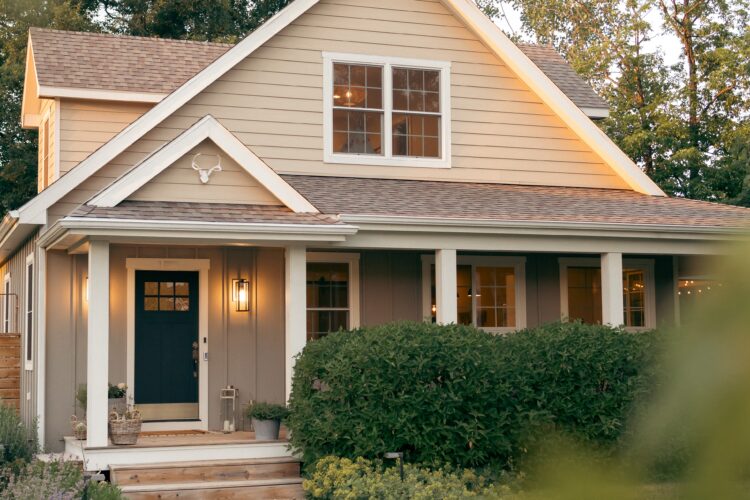
- By LADA Exteriors
- In Renovation, Repairs
Safeguarding Portland Siding from Mold and Mildew
Your home is more than just a place where you spend time; it is a significant investment, and among the crucial components of this investment is your siding. However, in the distinctive climate of Portland, an insidious but potent adversary challenges your siding: mold and mildew. This will help enlighten homeowners about how Portland’s humid climate impacts siding and suggests measures to shield homes from the damaging effects of mold and mildew.
Portland confronts high humidity, frequent rainfall, and diminished sunlight during specific seasons. These conditions collectively create an ideal environment for the proliferation of mold and mildew, particularly on exterior surfaces such as siding.
Mold and mildew, classified as fungi, flourish in damp surroundings. They propagate by releasing spores into the air, which adhere to surfaces and proliferate. Beyond causing unsightly stains and unpleasant odors, these fungi can compromise the structural integrity of your siding, paving the way for potentially expensive repairs in the future.
Distinct types of siding react differently to the presence of mold and mildew. Wood, for instance, absorbs moisture readily, rendering it highly susceptible to fungal growth. Though less absorbent, vinyl can still harbor mold and mildew in cracks and seams. Fiber cement, while resistant to moisture, is not entirely immune.
Recognizing the signs of mold and mildew on your Portland siding is crucial. Visual cues include the appearance of black, green, or brown spots. An unappealing musty smell surrounding your home’s exterior can signal its presence, as can physical damage such as warping, cracking, or peeling paint. Apart from the aesthetic issues and discoloration from stains, the structural damage caused by mold and mildew can be extensive if left untreated.
The mantra of prevention being better than cure holds in this context. To shield and prolong the life of your siding, consider the following preventive measures from siding experts.
Proper Ventilation
Proper ventilation is essential for maintaining a healthy and moisture-free home environment. Implementing ventilation strategies, such as using exhaust fans, opening windows, and maintaining air circulation, is a proactive measure to safeguard against potential issues associated with excess humidity.
Regular Cleaning
Regular cleaning is a crucial maintenance practice to preserve the longevity and aesthetics of your siding. Periodically cleaning your siding with a gentle mixture of mild detergent and water is a preventive measure against mold and mildew growth. This routine removes accumulated dirt, grime, and potential contaminants, ensuring that your siding remains visually appealing and structurally sound.
Mold-Resistant Materials
Consider incorporating mold-resistant siding materials to fortify your home against the persistent threat of mold and mildew. These specialized materials are engineered with properties that actively deter fungal growth, providing an added layer of protection for your exterior surfaces. Investing in such materials ensures a durable and low-maintenance solution, enhancing your property’s longevity and visual appeal.
Professional Assistance
Seeking professional assistance is essential for efficient mold and mildew removal, ensuring a thorough and effective resolution to potential issues. Trained experts possess the knowledge, experience, and specialized tools needed to address these concerns comprehensively. By enlisting professional services, you not only eliminate existing mold and mildew but also prevent their recurrence.
Common Questions About Mold and Mildew Growth
Impact on Longevity
The impact of mold and mildew growth on the longevity of siding materials is substantial, potentially resulting in premature deterioration and costly replacements. These insidious fungi compromise the structural integrity of siding, causing warping, cracking, or peeling. Left untreated, the consequences can be severe, necessitating early intervention or complete replacements. Homeowners must prioritize preventive measures and regular maintenance to counteract the detrimental effects of mold and mildew, ensuring the extended lifespan of their siding and avoiding the financial burden associated with extensive repairs or replacements.
Health Concerns
Health concerns arise when mold and mildew on exterior surfaces find their way into your home. Though these exterior growths may not directly impact indoor air quality, their infiltration can release spores, posing health risks. Allergic reactions, respiratory issues, and other health problems may result from exposure to these spores. Regular maintenance and proactive steps contribute to a healthier living environment for you and your family.
Resistant Siding Materials
Siding professionals strongly advise opting for resistant siding materials, such as fiber cement, renowned for their heightened ability to withstand moisture and resist mold and mildew growth. While these materials offer enhanced protection, it’s crucial to emphasize that regular maintenance is imperative for all siding types. Even moisture-resistant options benefit from periodic cleaning and preventive measures. Regular upkeep complements the inherent resilience of these materials, contributing to a durable and attractive exterior.
Mold and mildew pose a genuine threat to your home’s siding and overall structure. Proactive maintenance and preventive actions are paramount in safeguarding your investment. Share this article with others to spread awareness, adopt preventive measures promptly, or enlist professional services to ensure your home remains in optimal condition. Don’t let mold and mildew compromise the integrity of your home—take preventive steps today.






